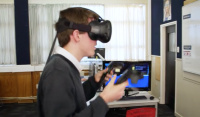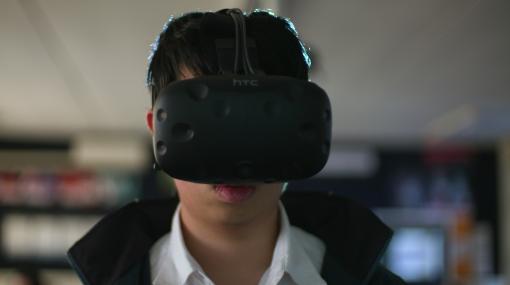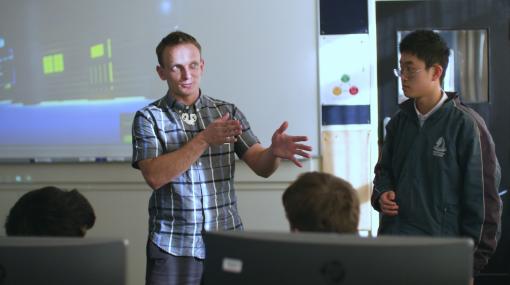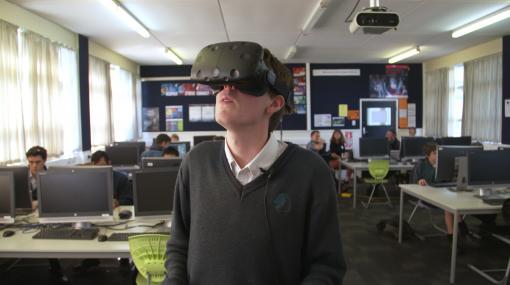Virtual reality
Students from Pakuranga College describe the 3D virtual reality game, Totally realistic sledding , they created as a collaborative project, and the skills they developed through the process.
What is virtual reality (VR)?
Virtual reality (VR) can be a powerful tool in supporting and facilitating STEM (Science, Technology, Engineering and Mathematics) education.
"Virtual reality entails presenting our senses with a computer generated virtual environment that we can explore."
Virtual reality describes a three-dimensional, computer generated environment which can be explored and interacted with by a person. That person becomes part of this virtual world or is immersed within this environment. While there, they can manipulate objects or perform a series of actions. A virtual environment should provide the appropriate responses – in real time as the person explores their surroundings.
VR is the use of computer technology to create a simulated environment.
Virtual reality is:
- believable
- interactive – as you move around, the VR world needs to move with you
- computer-generated
- explorable – a VR world needs to be big and detailed enough for you to explore
- immersive – to be both believable and interactive, VR needs to engage both your body and your mind.
For the complete VR experience, three things are needed:
- a plausible, and richly detailed virtual world to explore – a computer model or simulation
- a powerful computer that can detect what you're doing and adjust the experience accordingly, in real time (so what you see or hear changes as fast as you move—just like in real reality)
- hardware linked to the computer that fully immerses you in the virtual world as you move.
More information »
- What is virtual reality? [Definition and examples] – a blog post by Dr. Brian Jackson from AR Blog.
How VR works
A user wears a headset that tracks their movements and displays video and audio according to their position. Video is split into two images, one for each eye, while also applying barrel distortion to each image to counter pincushion distortion from the lenses. The result is a stereoscopic (“3D”) image with a wide field of view. Combined with stereoscopic 360 degree audio, a user can view and interact with an environment.
Preparing for using VR
Before adopting a new technology like VR into the classroom, consider:
- what are the benefits of using VR?
- what purpose and function will it fulfil in the school curriculum?
- how will the technology be used and managed?
- how will these devices and software fit into existing ICT resources and at what cost?
- what professional learning and development do teachers need to use VR?
Pakuranga College is a future focused school. They are growing a digital technologies programme that encourages lifelong learning and prepares students for future career opportunities. They recognise the new digital technology strands are going to have a significant impact on how they deliver the curriculum, particularly in the junior school. By building on their senior school NCEA programme to provide an introduction to 2D and 3D programming at years 9 and 10 they are developing a seamless learning pathway. Currently, VR is an extension opportunity and a way for students to develop coding skills. Their aim is to build capacity within the school to bring VR into the curriculum and the timetabled classes.
VR provides an authentic context for students to engage with digital content, and learn about computational thinking and programming.
Teaching using VR
VR promotes content-rich learning and social interaction inside the classroom. There are two main ways of using VR in your teaching programme:
1. Viewing VR – an immersive experience
Students can participate in VR field trips watching 3D videos and using 3D apps, or play VR games. Using VR provides an immersive experience where students can engage with content. The visual element of VR enhances the relationships between concepts and information. Sometimes it is easier to see and hear something than have it explained to you. Tools like Google Cardboard are both a platform and a product to experience and encourage interest in VR.
Tools to explore
- Google's Virtual & Augmented Reality for education – Google offers a range of virtual & augmented reality products for education.
- Minecraft offers a VR version, which can provide an extension of gamification in the curriculum.
2. VR creation – developing 3D worlds and games
VR technology offers scope for game development, design, and coding. Students need a basic computer literacy and the willingness to learn about a new interface.
At it's simplest, VR can be engaged with using a 360 degree camera to create images and videos for VR. At a more complex level, students can create, and interact with:
- 3D worlds
- short films, animated tales, documentaries
- games.
Students develop coding, design, computational thinking, problem solving, and collaborative skills within this context.
Tools to explore
- CoSpaces – CoSpaces Edu provides students with all the tools they need to create, code, and explore their own virtual worlds, even in VR. The simple and easy to use platform can be operated across all devices – desktop browser or Chromebook, or the companion app for tablets and smartphones.
- Unity personal – a free version of Unity which students can use. It contains several tutorials and students can connect with a community of game creators.
- Get started with Google VR in Unity – this guide shows you how to set up Unity for Google VR development and build a demo scene.
- VR at Google – Google provides developers with two virtual reality (VR) platforms: Cardboard, an accessible mobile VR platform, and Daydream, a platform for high quality, mobile VR.
- Robot Virtual Worlds offers a virtual platform to test robots without hardware. Currently, it has both Lego Mindstorms and Vex Robotics versions.
Students at Pakuranga College talk about the 3D virtual reality game they have developed and the skills they learned when creating the game. Students worked as a team with specific roles including: planning the game, designing and creating 3D assets, programming, and marketing. "There are skills you can’t learn inside the classroom that we learn when we make a game....you’re not just trying to make the best programme, you’re trying to make a game. You want to finish the game and make it run well. We’ve had to work under a lot of time pressure.....You learn to solve problems."
Connecting with other game developers beyond the classroom was a factor in the success of the students' game, Totally realistic sledding VR .
To make connections beyond the classroom, the students used:
- Discord – A free communication channel for gamers, which students used to share progress and invite feedback on their game
- Auckland game developers meetup – A group for game developers, programmers, and artists involved in gaming to get together and share ideas.
VR and computational thinking
Computational thinking can be loosely defined as, "the habits of mind developed from designing programs, software packages, and computations performed by machines" (Denning, 2017 ).
An algorithm is a series of steps that control a computational model, without requiring human judgment. "Computational thinking includes designing the model, not just the steps to control it"
(Denning, 2017
).
Computational thinking will better prepare students for living in an increasingly digitalised world. It improves problem solving skills.
| Computational thinking characteristics 1 | Enactment |
| Formulating problems in a way that enables students to use a computer and other tools to help solve them. | Virtual simulation is one way to visualise and gain experience of an issue being inquired into. This could be a virtual experiment, exploring an historic event, or solving a problem. Problems can be replicated or hypothesised using virtual 3D spaces linked to real-world, physical artefacts creating scenarios to be solved. |
| Logically organising and analysing data. | Data gathered from a task is analysed to inform the next step(s). A variety of technologies can be used to gather and interpret data, ranging from a spreadsheet and graphs to visualising data in 3D VR. |
| Representing data through abstractions such as models and simulations. | These can be simple simulations using Scratch that students develop to more complex 3D games/simulations . |
| Automating solutions through algorithmic thinking (a series of ordered steps). | Students can develop programming skills at a range of levels using different software such as Scratch , Minecraft VR , LEGO Mindstorms , and Unity personal . |
| Identifying, analysing, and implementing possible solutions with the goal of achieving the most efficient and effective combination of steps and resources. | By taking a logical, ordered approach towards a solution and testing the outcome students develop problem solving skills. They can work individually or collaboratively. This can be done through testing to develop a successful program, for example Pakuranga College students tested and re-tested their game simulations making programming changes until it was successful . |
| Generalising and transferring this problem solving process to a wide variety of problems. | Students use their knowledge of program sequencing and apply it to different situations and software. The experience of transfer supports students in their attempts to manage complexity and abstraction. |
| Reflecting on learning experiences through feedback. | After each task, students discuss their problem-solving strategies, the communication successes and deficiencies, and their programming skills. They may use a channel, such as Discord to engage with others beyond the classroom. Reflection helps students set goals for the next task. |
1 Computational thinking characteristics from Vallance, (2016)
Pakuranga College ICT faculty leader, Charlie Smith, and teacher, Tyne Crow see VR as a technology that's going to grow in the near future. To build teacher capacity, they have begun by developing a culture within the school where people were comfortable using the VR technology. They purchased equipment and have initiated a game development group, where students can code and develop 3D games during lunchtimes and after school. They describe the technology they are using with students and the benefits for learning.
Equipment for using VR with students
The type of equipment you choose to use depends on how you want to use VR in your teaching.
The cheaper equipment, cardboard headset with a smartphone enables students to watch 3D videos, which are available from free VR apps like Orbulus, Trench Experience VR, and Cardboard. There are also several on YouTube made with 360 cameras.
The more expensive equipment includes:
- head-mounted displays (HMDs)
- immersive rooms
- datagloves
- wands.
More information »
- Virtual reality – part of an online book by an online book, Explain that stuff by British science writer Chris Woodford.
Infrastructure considerations
- Do you have the infrastructure in place both wired and wireless to adequately support VR?
- How will it affect your school's wifi performance?
- Will student-owned VR headsets be allowed through BYOD?
References
Vallance, M. (2016). Advancing computational thinking and knowledge development in a 3D virtual simulation. Bulletin of the IEEE Technical Committee on Learning Technology, Volume 18, Number 2/3, 2016
Sorry, no items found.
Readings
What is virtual reality? [Definition and examples]
A blog post by Dr. Brian Jackson from AR Blog.
Part of an online book by an online book, Explain that stuff by British science writer Chris Woodford.
Game developers
New Zealand game developers association
Formed in 2001 to champion, support and grow video game development in New Zealand. It is a not-for-profit incorporated society. Students are welcome to join.
Auckland game developers meetup
A group of game developers, programmers, artists, musicians, animators and game enthusiasts that meet to discuss game design and collaborate on computer game projects. Members include students, hobbyists and professional game developers.
Based in the UK, provides information on apps and equipment.
Equipment, Apps, and videos
Google's AR and VR educational tools
Google offers a range of AR / VR educational tools
VR apps and games.
Best Android VR apps and games: The top virtual reality apps for Android
TechAdvisor blog post by Dominic Preston (June 2017) recommending VR apps for android.
CoSpaces Edu provides students with all the tools they need to create, code, and explore their own virtual worlds, even in VR. The simple and easy to use platform can be operated across all devices – desktop browser or Chromebook, or the companion app for tablets and smartphones.
A list of VR resources for schools developed by the Digital Fluencies team at the University of Waikato.
Teaching
How one teacher got started with virtual reality in the classroom
A blog post (Feb 2017) describing how a US middle school social studies teacher used VR as an immersive experience, by Elizabeth Mulvihill on the We Are Teachers website.







